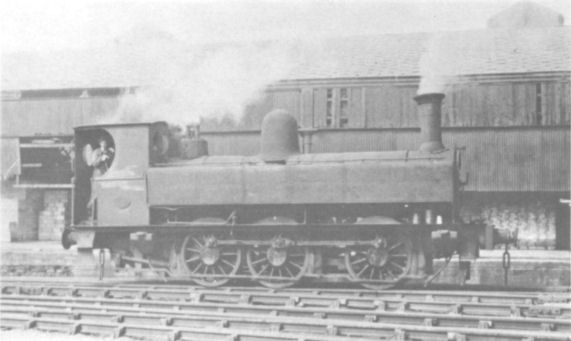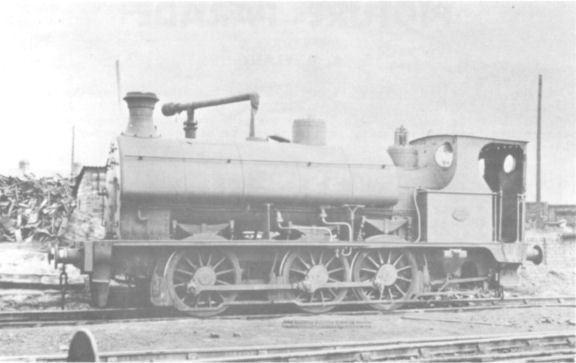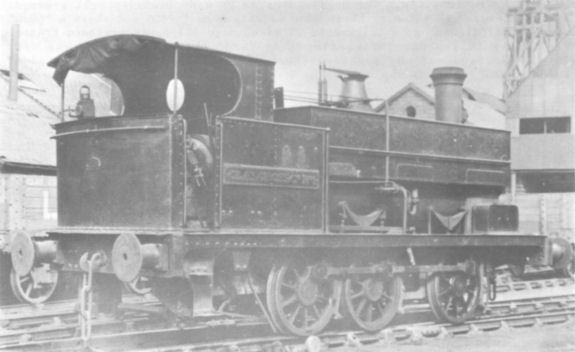
| THE INDUSTRIAL RAILWAY RECORD |
© FEBRUARY 1968 |
|
SOME LONG BOILERED
|
FRANK JONES |
For my subject this time, I have taken long boiler six coupled tanks. The term "long boiler" means that the firebox is behind the rear axle. This is true of most four wheelers, but with six coupled locomotives there is normally room for the firebox to fit between the last two axles. However, in mid-Victorian times the call for more power meant longer boilers. The firebox was not put between the last two axles as it would have meant too much weight and overhang on the front axle, whilst still retaining a useful short wheelbase. The compromise was adopted by moving forward the rear axle until the rear and centre wheels almost touched, and then putting the firebox behind all.
I cannot say who was the first maker to adopt the design and lists do not differentiate between designs. In my collection is an official photograph of Dowlais No.1 SAMSON (Kitson 701 of 1859) of this type – a pannier tank with outside frames and although the axle box volute springs are in neat covers, there is no cover at all for the driver!
South Wales and the North East were the main areas to have them, with a few in Lancashire. The design disappeared towards the end of the 19th century with the coming of increased diameter boilers. The Consett iron Company developed their long boiler Kitson saddle tanks of the 1870’s into pannier tanks which were constructed by various makers not normally associated with the long boiler design, the last coming from Robert Stephenson & Hawthorns in 1941. (Manning Wardle 1207 of 1890, THE WELSHMAN, would seem to be Manning’s sole contribution.)
(Ahrons states that the long boiler design was introduced by Robert Stephenson in 1841 with two 2–2–2 passenger tender engines – one for the York & North Midland Rly. and the other for the Northern & Eastern Rly. (a 5ft 0in gauge line between London and Bishop’s Stortford). Stephenson’s supplied drawings to several other firms who built the "patent" engines top both 2–2–2 and 2–4–0 wheel arrangements. Additional details may be found in Ahron’s "The British Steam Railway Locomotive".
Further contributions on this subject are invited. Ahrons says nothing about industrial designs and it would be of interest to determine the first long boiler locomotive built for industrial use. THE WELSHMAN was not the only manning Wardle long boiler locomotive, as eleven built in the 1860’s are noted as such in the official Engine Book. These are 88 and 89 of 1863 and 109 of 1864 (for the New South Wales Government Railways, Australia), 92 of 1863 (T. Nelson, contractor), 110 of 1864 (Hucknall Colliery Co.), 126 of 1864 (E. Waud, Manston Colliery, Leeds), 127 of 1864 (J. Bray, Konigsberg), 134 of 1864 (A.M. Mundy, Shipley Colliery), 140 of 1864 (R.S. France, Llanymynech – later Mawddwy Railway), and 183 and 184 of 1866 (North Eastern Railway, 522 and 523). The last two were 0–6–0 tender engines, but the others were all 0–6–0 saddle tanks. – Hon. Eds.)
My pictures show below [top] Barrow Steel pannier tank No.27 in 1954 (Kitson 2343 of 1880), and Barrow Steel saddle tank 22 (Sharp Stewart 2503 of 1875) taken in 1950 [middle], and CLAY CROSS No.1 (Stephenson 2107 of 1873) taken at Clay Cross in the 1930’s [bottom]. The latter has a typical Stephenson box tank. Clay Cross is a case in point of not relying on lists, for although there were earlier locos built by Stephenson here, photographs do not show them to have long boilers.



For the record ….
"STOCKSBRIDGE RAILWAY. – On Tuesday afternoon, a large and very powerful new locomotive made its first trip on the Stocksbridge Railway, which is now nearly completed. The engine is called "WHARNCLIFFE", and weighs about 25 tons."
("Iron", Friday, 21st July 1877.) (K.P.P.)
"The Societe Metallurgique Belge has succeeded in getting rid of a job lot of twelve locomotives, which have been lying on its hands since the bankruptcy of the Bassins houilleurs company, for which they were built. They were sold abroad, and ten others, four from the Societe Belge de construction, two from the Saint-Leonard company at Liege, and four from the Cockerill company, have been sold during the past week, all on foreign account. They were all in hand, having been ‘got up’ during spare time, and were ready for immediate delivery."
("Iron", Friday, 3rd November 1877.) (K.P.P.)